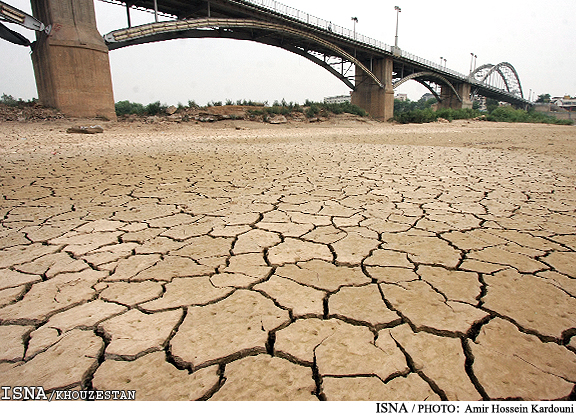Podcast: Play in new window | Download
Subscribe: RSS

Bridge Over Vanished Water: A dry riverbed in the Al-Ahwaz region of Iran, site of the country’s worst drinking water crisis, 90 per cent of Iran’s oil production, one third of the country’s water and the most polluted city on earth. (Ahwaz News Agency photo)
Iran, the country that American sparrow hawks have pencilled in for our next invasion and 20-year war, is beginning to die of thirst. Its government is often fighting pitched battles with citizens desperate for water, and is preparing water-rationing plans for its biggest cities including Tehran. Its new president, Hassan Rouhani, has identified water as a national security issue and has promised his people to bring it back. Nice trick if he can do it.
Major rivers in Iran (think the Colorado River in just a few more years) have gone completely dry, as have large lakes such as Hamoun, near Afghanistan, and Urmia, once one of the world’s largest salt lakes (think California’s Salton Sea). Wasteful irrigation (they simply spray water into the hot, dry air), a profusion of dams trying to keep up with demand for electricity, and a burgeoning population sinking wells everywhere for drinking water, have all contributed to a dramatic depletion of available surface water.
The New York Times yesterday profiled the woes of Lake Urmia. As a salt lake, larger than Utah’s Great Salt Lake, it was never any use for irrigation or drinking, but it supported wildlife, a fishery and a large tourist trade. 95 percent of its water is gone. Now, where water was 30 feet deep a few years ago, there are vast salt flats whose dust is worsening the dense air pollution for the three million people who live nearby, and threatening to poison vast expanses of agricultural land.
The same population that is increasingly thirsty, and restive because of that, is also short of electricity and, yes, petroleum. All those dams, and the well known nuclear program that has given so many people visions of mushroom-shaped clouds, are part of the government’s desperation to meet the demands of its people.
How could a country that has the second largest oil reserves in the world be short of petroleum? First, because it does not refine much of its own products and has to import gasoline and diesel fuel at considerable cost. Second, Iran sells these products to its people at well below cost. As the population grows, becomes more prosperous, buys more cars and trucks, drives them more, the cost of the subsidies to the government grows. It has reached $84 billion a year with no end in sight. Once, the government started to begin to reduce the subsidies, and so many people were in the streets instantly the government caved in about 24 hours.
The future of Iran, its people and its government does not depend on nuclear weapons, or fundamental Islam, or some nascent love of democracy, but on whether people have water to drink, food to eat and fuel for transport and business. Take away any one of those and people riot, governments fall and economies crash. Look up “Arab Spring.”
Good luck, President Rouhani, bringing the water back. Your life may depend upon it. Oh, and President Obama? Take a note.